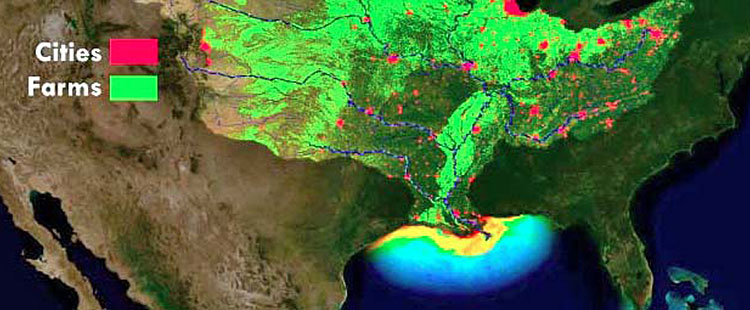Dangerous toxins are pouring into waterways around the world, exacerbating massive, harmful algae blooms that create oxygen-deprived stretches of the ocean. Hundreds of aquatic dead zones exist throughout the world, covering nearly 100,000 square miles of sea and causing the relocation or death of nearly 10 million tons of biomass annually. Once filled with life, these ecosystems are left barren, causing unprecedented pressure on the private sector and federal governments to increase restoration and cut this pollution at its source.
The National Oceanic and Atmospheric Administration announced that this year’s dead zone in the Gulf of Mexico is the largest ever recorded. From the coast of Louisiana at the Mississippi River Delta and to the shores of Texas, the area of severe hypoxia in the Gulf of Mexico has reached an unprecedented 8,776 square miles so far in 2017. That’s the size of 4 million soccer fields.
Aquatic Dead Zone in the Gulf of Mexico
Source: National Oceanic and Atmospheric Administration (2017)
Why is this happening? An excess of agricultural nutrients intended to increase the productivity of crops flows downstream and into surface waters, wreaking havoc on oceans hundreds of miles away. Eutrophication, or the excess enrichment of the environment with nutrients, is a phenomenon catalyzed by the industrialization and centralization of commercial agriculture over the last century. The dead zone in the Gulf of Mexico is a prime example, caused by agricultural runoff in the United States. 1.15 million metric tons of nitrogen pollution flowed into the Gulf of Mexico via the Mississippi river in 2016 alone. That’s 170% more pollution than was dumped into the Gulf from the BP oil spill in 2010. Initial figures from the United States Geological Survey estimate that 165,000 metric tons of nitrate and 22,600 metric tons of phosphorus flowed down the Mississippi and Atchafalaya rivers into the Gulf of Mexico in May 2017 alone. Shrinking the size of this dead zone to a still substantial 1,950 square miles will require a 59% reduction in the amount of agriculture runoff.
Chemical Runoff Flowing Down the Mississippi River
Source: National Oceanic and Atmospheric Administration (2017)
According to the US Environmental Protection Agency, water pollution from agriculture is one of the ‘most widespread, costly and challenging environmental problems’ that we face in the world today. Industrial agriculture is increasingly responsible for contaminating our water and destroying the environment. What may be surprising is that this is mainly due to the meat industry, which has converted vast amounts of native grassland to produce crops for their livestock. The unprecedented demand for meat has resulted in the application of over 186 million tons of fertilizers on our soils, one of the world’s most valuable resources.
The nutrient makeup of our soil has never before been altered at such a large scale and over a relatively short period of time. While this has caused severe environmental issues, we must never lose sight of the fact that fertilizers have and continue to strengthen our global food supply, preventing millions of people from starvation. Mankind is faced with the significant challenge of producing more food in the next four decades than we have over the last 10,000 years. We must, therefore, identify the issues in current fertilizer use, strengthen our understanding of soil health and drive innovation that will ensure crop care becomes safe and sustainable for generations. What is becoming increasingly clear is that we do not have any other choice but to develop and enhance natural fertilizers so they no longer damage the very resource that we are attempting to nourish. The consequences of ignoring this warning will be a catastrophe on a Malthusian scale.
Sustainable, regenerative agriculture is already being used around the world to produce more food with fewer environmental impacts, yet this must be evolved at a much greater pace to restore environments destroyed by the greed of profit at any price.
By diversifying beyond industrial monocultures to include rotationally raised small grains and intercropping, implementing safe and responsible crop care management practices and raising transparency across the industry, we will help drive a new green revolution that will secure our global food supply. We believe that the solution really is neem, a natural resource that increases the soil’s nutritional content while protecting plant roots from pests, diseases, and nematodes. Packed with nutritional value, neem offers a 15-25% increase in yield when compared with all other natural fertilizers and is currently being utilized alongside synthetic fertilizers such as Urea to slow nutrient release. Read more about why this is an essential service in one of our previous newsletters – The Fertilizer Upgrade of the 21st Century.
This is more than just an update on the current, flawed approach witnessed in conventional agriculture every single day, this is a warning and a call to arms for our readers to be aware of the archaic and dangerous practices in the sector and demand positive change.
While known by agronomists, environmentalists and healthcare specialists around the world, neem continues to be one of Planet Earth’s best-kept secrets. With global pressures accelerating a shift towards natural solutions, we know that neem’s ascension into the mainstream will be exponential. This will be achieved with the help of Neem.World and Neempedia, digital resources that shape awareness of the United Nations Tree of the 21st Century. Please like, follow and share to become part of this global movement.










